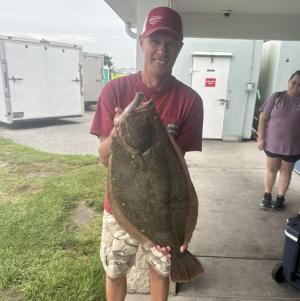That’s right – fall is sneaking up on us, and soon the little darlings will be back in school, the summer vacations will be over ... and the traffic on Route 1 will hardly show any difference.
As far as fishing goes, this is the time when the baitfish move out of the marsh and start migrating down the coast. Mullet are the primary bait in this region, and when they begin to move, just about every game fish in the ocean will soon follow. Of course, menhaden, aka bunker, will also school up and attract larger game fish such as cobia and striped bass.
Flounder fishing has been dismal since the size limit increased to 17.5 inches. Combine this with cold water on the bottom in flounder fishing areas such as the Old Grounds, and you have a one-two punch to the gut for flounder fishermen.
Delaware Bay and Indian River Inlet have produced some impressive flounder over the summer, and it is possible larger fish from these locations could be available during the fall migration.
Flounder move from inshore to offshore in the fall to spawn. The fry then move back to the Inland Bays to grow up before they become large enough to spawn. Each class of flounder moves farther north, and that is why the largest flounder are caught on Nantucket Shoals.
Back in the day, when we would drift live eels for stripers at the mouth of Delaware Bay, a few big flounder would be caught. I would suggest drifting with live spot at the Eights or any of the other rips during outgoing water, and you may surprise yourself with the size of the flounder you catch.
Drifting the same bait just outside the breakers along the ocean beach is another good technique. You do have to keep watch for the occasional rogue wave that can sneak up on you and spoil your day.
Live spot are a good bait for big trout or weakfish. Many years ago, Leonard Maull from Henlopen Tackle and I split three dozen of Mrs. Murray’s spot and headed to Fenwick Island on a November afternoon. We fished till dark and had a trout on every cast. At the end of the afternoon, we had 29 in my cooler.
I have seen more big trout this year than I have seen since then. Most have been caught from hard structure such as the Inlet rocks, the jetty at Roosevelt Inlet, the Outer Wall and the jetty at Bowers Beach. Presenting a live spot in those places is difficult, but possible. I do believe the trout will migrate along the ocean beaches just like they did back then, and that’s where I would drop my spot or bunker.
Blues have been running through Indian River Inlet during incoming water for well over a month. I don’t know exactly what bait they are eating, but it looks like a white bucktail with a white worm. Right after Hurricane Debby passed, the blues were joined by ribbonfish. The ribbons ate the bucktails as well as metal spoons. The blues ran 5 to 10 pounds, and the ribbonfish were quite large as well.
There is no reason to believe the blues won’t hang around all fall. As long as there is bait in the water, the blues will be here. One of surf-fishing’s great moments is casting surface lures to schools of bluefish busting bait.
Never forget striped bass. The night shift at the Inlet has been catching them all summer on live eels or drifted sand fleas. A few have even been taken during the day on various baits or lures.
One visitor to our shores is the cobia. They don’t behave like normal fish, but that’s a subject for an entire book. If you spot a school of menhaden, there’s a fair chance a cobia is close by. Try casting a gaudy bucktail, a live eel or a live menhaden if you see the cobia. From the surf, try a live spot, croaker or chunk of bunker.
Bottom fish can also provide good action in the fall. Last Nov. 3, I went out on the Angler from Ocean City, Md., and had one of the best days of bottom fishing I have ever had.
My first drop was around 8 a.m. and my last was around 2 p.m. During that time, I caught at least one and often two sea bass on every drop. I ended the day with 20 keepers over 13 inches. I only had two drops where the fish got my bait and one drop where I caught a smooth dog shark. The five extra keepers were given by the mates to less-fortunate anglers.

























































